How to determine the location for the well on the site: the
Where to locate the well on the site? The question is far from idle: when choosing, it is worthwhile to take into account both sanitary standards, and your own convenience in the process of operation, and minimal costs for drilling and equipping. So what should you pay special attention to?

Criteria List
In general, we have already listed the main thing.
Let's elaborate a bit the list of factors affecting the location of the well in the area.
- We need to keep the minimum necessary distance from all sources of pollution. The closer a well is to a septic tank filter well, a compost pit or a street toilet, the more likely it is to get substandard water.
However: if the well is planned to be used exclusively for irrigation, this item may not be given special attention.
- The distance to the house and other buildings that use water should be as short as possible. Laying of inputs is carried out below the level of soil freezing. Digging multimeter trenches of considerable depth is hardly fun for us.
- Soil and relief features will also have to be taken into account. The slopes, the rock base on the part of the site, the lowlands, the groundwater level - all this affects the location of the well on the site.
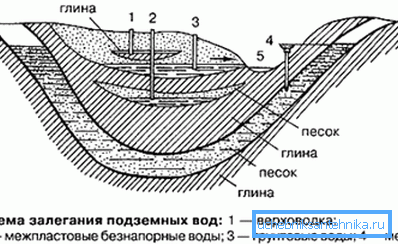
Sanitary standards
So, what they say about the arrangement of water intakes?
Formal requirements
Sanitary regulations and standards SanPiN 2.1.4.1110-02 in its paragraph 2.2.1.1 unambiguously say that the minimum distance from the water intake to residential and industrial buildings is:
- When using protected groundwater - 30 meters.
- When using poorly protected underground sources - 50 meters.
The instruction is not quite clear? Well, let's decipher it.
To do this, you will have to become familiar with several general concepts.
- Distinguish drilling on the sand - to the upper aquifer and limestone - to the bottom. A clear boundary between them can be determined only with regard to the structure of soils, there is no unambiguous division by depth; However, there is a very important difference between them. The lower aquifer is separated from the surface by a waterproof layer of clayey soil and does not communicate with it.
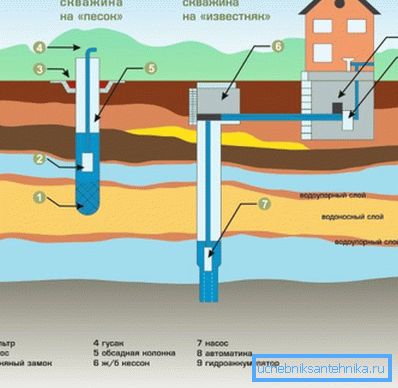
Captain Obviousness suggests: wells on the sand belong to poorly protected water intakes, since their bacterial contamination or contamination from the surface is quite likely. Limestone wells are much better protected; the probability of their infection is reduced to the few cases in which polluted drains can move along the wellbore or other vertical shafts.
- As it is easy to notice, industrial and residential buildings are mentioned as a source of probable contamination or bacterial contamination. Why? Yes, because all of them are equipped with a sewage system with gravity movement of polluted (chemically or bacterial) wastewater.
And what from this? Well, sewage flows from the pipe to the well. What effect does this have on soil contamination?
Perhaps, dear reader at least once was near a large reservoir into which a rain sewage opens. It's hard not to notice that the drains from the storm wells have a noticeable smell, excuse me, fecal water.
The secret to the appearance of odors is simple: both wells and collectors do not have absolute tightness. A substantial part of the effluent is safely filtered into the ground, falling, among other things, into equally leaking wells and storm water collectors.
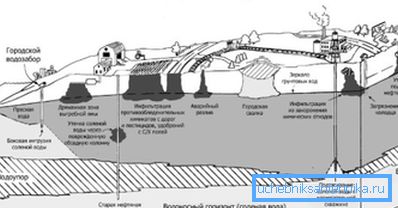
Summarizing all the above, you can put a simple rule: the sanitary zone of the well on the sand separating it from any source of soil pollution is 50 meters. For a limestone well, the distance can be reduced to 30 m.
Loophole
The price of drilling a running meter of a well is on average 2–3 thousand rubles. Yes, this work can often be done by hand; However, without the involvement of technology can only be drilled in the upper aquifer.
If we take into account the fact that a rare site reaches 50 meters in at least one direction - the situation is just awful. Is there no way out?
Let's think a bit.
How does contaminated water from the surface layer reach the well pump?
- A very small amount of it is filtered through the upper layers of the soil.
- The bulk flows through the well itself, between its walls and the casing. If we are talking about lower aquifers, there is no other loophole for surface water.
It is a logical decision to cut off the migration of water between horizons, cementing the well. This is what is done when it is necessary to place water intake near a potential source of pollution. The space between the casing and the walls is filled with quick-hardening cement mortar, after which the water to the water intake comes only and exclusively from the lower layers.
Please note: this work is done with the help of concrete pumps, applying a solution under high pressure. Attempting to pump a well manually will cause you to create a small cork around the casing; down the concrete will not fall.
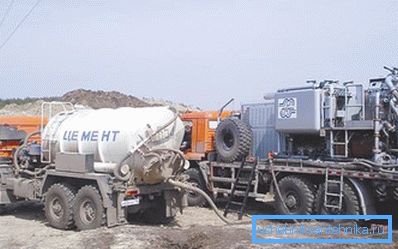
Distance from the consumer
From this point of view, everything is simple.
- A reasonable minimum distance from the well to the foundation is 3 meters. Further approximation is fraught with ground movements during drilling. Either it draws the foundation, or under the influence of its weight the wellbore will fall.
- The maximum distance is limited only by your love of earthworks and the pressure created by the pump. Do not forget that the pressure is lost even in the horizontal pipe.
Relief and ground
Where it is better to make a well on a site with difficult terrain?
- On a slope with a slope of 35 degrees and above, drilling is impossible. The rig simply does not have the technical capabilities for this.
- Lowlands are preferred. Provided that the aquifer is horizontal, drilling in the lowlands will reduce the length of the wellbore, thereby reducing your costs.

- Wetlands, however, should be excluded from consideration. Eternally filled pit and the flow of water from the surface into the well, we do not need.
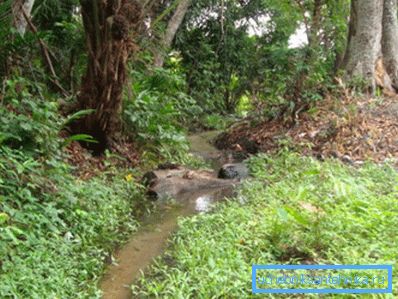
Where to make a well on a site with dissimilar soils? Where the soil is easier to give in to borax. The choice between the rock base and sandy loam is quite clear; black soil, obviously, is more preferable than clay with large stones.
Conclusion
We hope that the article will help the reader to make an informed decision (find out here how to find water for a well).
Perhaps the video in this article will also be useful when choosing. Successes!